Over 210,000 Irish enlisted in the British Army during World War I. Among them were doctors such as my grandfather who tended the wounded and saw the brutality of modern warfare up close.
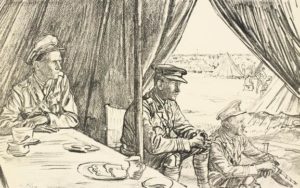 Waiting for the Wounded: “A British advance has just begun, and the surgeons of a Divisional Collecting Station near the Somme are awaiting the arrival of the first laden stretcher-bearers. In a few minutes, the three officers will be at work, perhaps for twenty-four hours on end. At one Casualty Clearing Station, a distinguished surgeon performed, without resting, nineteen difficult operations, each lasting more than an hour, in cases of severe abdominal wounds, where delay would have meant the loss of life. In almost every case the man was saved. Another surgeon operated for thirty-six hours without relief. Such devotion is not exceptional in the R.A.M.C.”
Waiting for the Wounded: “A British advance has just begun, and the surgeons of a Divisional Collecting Station near the Somme are awaiting the arrival of the first laden stretcher-bearers. In a few minutes, the three officers will be at work, perhaps for twenty-four hours on end. At one Casualty Clearing Station, a distinguished surgeon performed, without resting, nineteen difficult operations, each lasting more than an hour, in cases of severe abdominal wounds, where delay would have meant the loss of life. In almost every case the man was saved. Another surgeon operated for thirty-six hours without relief. Such devotion is not exceptional in the R.A.M.C.”
– Muirhead Bone, British War Artist.
We didn’t talk much about my grandfather (pictured center in the sketch above) when I was growing up. He had been a doctor in the British Army, decorated for his service in the First World War, but the bitter War of Independence had left its mark on Ireland, and while many families had relatives in the British Army who fought at the front, it wasn’t something you bragged about. It’s only as an adult then that I have started to look deeper into my grandfather’s life.
His name was William “Bill” Egan and he was born on September 30, 1881, into a farming family outside the town of Dungarvan, Co. Waterford, the youngest of three sons of Anne Duggan and Maurice Egan.
He was educated at St. Vincent’s College, Castleknock; Queens College, Cork, and the Royal University of Ireland, Dublin.
After graduating from medical school in 1906, he worked as a resident surgeon at the Waterford Infirmary for 12 months before joining the Royal Army Medical Corps and embarking on his first tour of India. Over the next several years, he served in Rawalpindi, Ferozepore, Multan, Rangoon, and Mandalay. In 1912, he returned to Ireland and did a short stint at the Curragh before leaving to take the Senior Officer Course at the Royal Army Medical College, London.
The First World War began on July 28, 1914, and two weeks later, my grandfather was on active service in France and Belgium. He was captured at Landrecies on October 18, 1914, and interned at Sennelager Prisoner of War Camp in Germany. Following his release on June 26, 1915 (in what I can only guess was a prisoner exchange), he returned to London and immediately married Norah Wall, a girl from his hometown. A month later he was back on active service, first with the Mediterranean Expeditionary Force in Malta, then Gallipoli, and then back to France and Belgium where he served as the Officer Commanding No. 44 Field Ambulance until near the war’s end in November 1918.
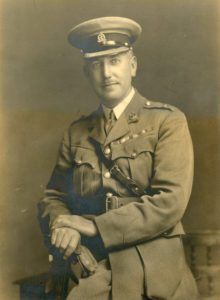
While his Army records afford us a timeline of his service, they don’t reveal much about his experiences on the battlefield. Thankfully, the surviving sketch of him at the Battle of the Somme, and the accompanying caption by the artist Muirhead Bone (printed at the beginning of this piece), help to fill in the gaps. The original, entitled, “Waiting for the Wounded,” is housed in the Imperial War Museum, London.
When I was a child a copy of this sketch hung in my parents’ bedroom, but I didn’t know its importance. Now, as we commemorate the centenary of the Great War, it has taken on new significance for me.
At the Battle of the Somme alone, 1,000,000 were wounded or killed. But my grandfather didn’t die in the war.
Incredibly, he survived the battlefields, malaria, “a whiff of gas,” and a German prisoner of war camp, only to die in 1929, from a ruptured spleen as a result of a fall.
By this time he was in Jamaica, in charge of the British Military Hospital there.
My mother, who was 10 when her father died, had few insights to offer on her father’s wartime experiences. She had her own war stories but they were all from WWII, when she was on the medical staff of St. Mary’s Hospital, London. Most memorable for her was working with Alexander Fleming, the Scottish scientist who discovered penicillin, and tending to French and British soldiers who had been invalided out following the Battle of Dunkirk.
My own insights into WWI come from books: British writer Sebastian Faulk’s Birdsong (1994) – so descriptive that 20 years after reading, I shiver at the images the author conjured up of the lice that lived in the dank wool of the men’s uniforms. The Irish writer Sebastian Barry’s book A Long Long Way (2005), also struck a chord with descriptions of the lives of the soldiers in the trenches and the gas attacks. Barry’s book is also insightful in exploring divided loyalties on the homefront as some Irish fought for independence and others fought at the front.
Both of these books made me think more deeply about my grandfather’s life and I wanted to know more.
Before he died, my Uncle Billy gave me an old photo album of his father, and, as the saying goes, a picture paints a thousand words. There were photographs of my grandfather as a young doctor at the Waterford Infirmary before he enlisted in the Army. Pictures of his life in India, before and after the war; my mother as a baby under the watchful eye of a turban-clad servant. Pictures of Kashmir; beautiful landscapes that my grandfather captured with his keen surgeon’s eye. There’s even one of my grandmother and him at the railway station in Quetta (now Pakistan). He was stationed there, on the Afghan border, during the Third Anglo-Afghan War.
There are also many happy photographs of the family in Jamaica.
Most poignant, for me, are the WWI photographs. There’s one of him on the boat to Gallipoli, another of him supervising the unloading of medical supplies; a photo of the camp in Alexandria from where he was invalided out after the ill-fated Gallipoli Campaign. There’s also a photograph of him in the German prisoner-of-war camp. I think it was probably staged for propaganda purposes (perhaps it was used as documentation in the prisoner exchange). He has a look on his face that says, “Don’t believe this.” I know from research that officers were reported to have been treated better than enlisted men, but according to one prisoner’s account of Senneglager camp in September 1914 when my grandfather was there, “it was an open field enclosed with wire… there were no tents or coverings in it of any kind. There were about 2,000 prisoners in it – all British. We lay on the ground with only one blanket for three men.”
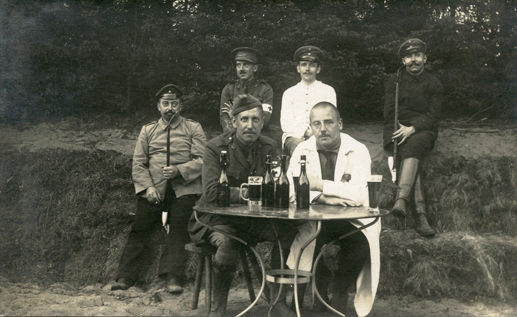
THE FRONT
“From a medical standpoint, World War I was a miserable bloody affair,” U.S. historian John Campbell wrote, giving me further perspective on my grandfather’s war years. “Generally there were four kinds of cases: gas injuries, shell shock, diseases, and wounds. World War I was the first conflict to see the use of deadly gases as a weapon. Gas-burned skin and irritated noses, throats, and lungs. It could cause death or paralysis within minutes, killing by asphyxiation. As soon as troops learned that gas was in their area, they had to put on masks. Even having the fumes in their clothing could cause blisters, sores, and other health problems. Bathing and changing clothes immediately helped but was not always possible. Many thousands of gas victims suffered the painful effects of damaged lungs throughout their lives.”
Campbell also wrote about the lice, quoting a soldier from North Carolina. “At first we had only one kind [of lice] but now we have the gray-back, the red, the black, and almost every color imaginable.” And the conditions in the trenches: “After they stood in water for weeks at a time, their socks would begin to grow to their feet. In severe cases, the soldiers’ feet had to be amputated.”
GALLIPOLI
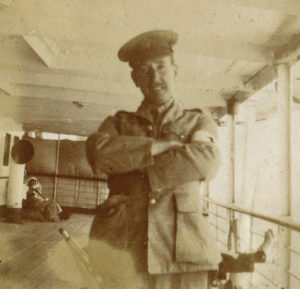
I keep returning to the photo of my grandfather on the boat to Gallipoli. He looks happy. He clearly didn’t know what was coming.
Intending to secure the capital of Constantinople (now Istanbul) on the northern bank of the Dardanelles, a strait that provided a sea route to the Russian Empire (one of the Allied powers during the war), Britain and France launched a naval attack followed by an amphibious landing on the peninsula.
The naval attack was repelled and after eight months of fighting, with thousands of casualties on both sides, the land campaign also failed and the invasion force was withdrawn to Egypt.
My grandfather was invalided out of Alexandria, and two months later he was back at the front where he would stay until close to the end of the war.
THE SOMME, 1916
If my grandfather kept a journal, it’s been lost to time, but some members of his unit, the 44 Field Ambulance, did put together a book of remembrances that my brother Noel discovered and put online (noelharty.net). The following unattributed excepts offer an insight into the daily life of the medics:
“One sometimes got downhearted at appalling casualties in obtaining what, in our hearts, we knew were meager results.
“It was always sad, after big pushes, to see bad cases, such as abdominals, put on one side to die, in order to give those less badly wounded the chance of recovery. . . . One abdomen, one laparotomy, means a whole hour devoted to an altogether uncertain result; it means, at most, half a chance of saving one man. An hour given to other severe wounds (heads, limbs, etc.) means that you will save three at least. Therefore, as the stream of wounded increases, one has to make a choice among the abdominal cases…. At last, an hour comes when one hesitates no longer, when one abandons to their uncertain fate all those with abdominal wounds, hoping, in order to calm the revolt against one’s own helplessness, that the very refusal to operate may be rewarded by some cures.
“Poor abandoned ones! We trust that God especially covered you with His wings and that your people at home never knew the tragedy of your last hours.”
ARRAS 1916
Also from the journal of the 44th Field Ambulance is this account of the Battle Arras: “An event which greatly impressed itself upon the minds of the nursing orderlies occurred on 2nd April, at about 8 a.m. A crowd of men walked in and said that a gas shell had dropped in their billet. They were put on stretchers and oxygen administered, but all were dead shortly after noon. Two days later we buried them; and, while we were in the cemetery, Fritz treated us to a small bombardment of gas shells, so we had to finish the burial with masks on. Col. Egan, by the way, got a whiff of gas a short time before.
“A general attack was made on 3rd May, the fighting with us being around Cherisy The unit dealt at Mercatel with ‘walking wounded’ only, and, roughly, two thousand casualties passed through our hands on the day of the attack.”
WAR’S END
The journal writers also grappled with returning to normal life, as the following shows: “The cessation of hostilities found most of us with feelings hard to analyse. The change came so quickly, and we were out in an odd corner of Belgium, with few other troops and with no civilians to rouse us up to work off our feelings. It was hard to realize that slime, mud, and blood would cease to be part of our life, or that timber and concrete would no longer be our normal environment. No more washing in water already twelve thick; back we were going for good to real beds, clean sheets, and clothes that knew not lice. Hurrah! Some regrets popped up, though. There were past failures and lost opportunities, e.g. why had we not handled that wounded limb more tenderly, why had we not spared a smile for that poor chap in pain on the stretcher, or had we done enough for that dying lad? But the Army is no place for much overthinking, so off we went to drag out the baron’s piano for song and dance. After a thanksgiving service, we settled down to ‘Pack up your troubles in your old kit bag.’”
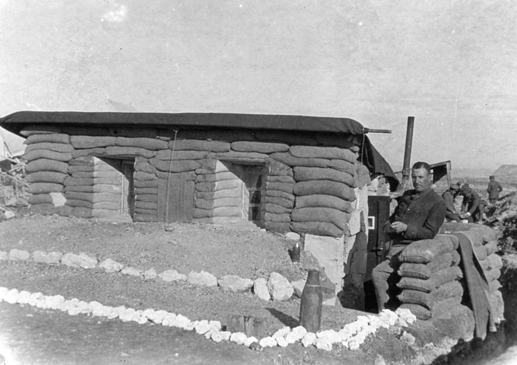
Following the war, my grandfather did a second tour in India. Then, from 1923 to 1927, he served with the Scottish Command in Edinburgh. (His image is on the Scottish National War Memorial). He was posted to Newcastle, Jamaica, in March 1927 and served there until his death on December 11, 1929. (He fell from a veranda onto concrete.)
Following his funeral my grandmother brought my mother and her two siblings back to Ireland. They never went back.
From not having had a strong appreciation for my grandfather, I’ve come to admire him, and to treasure each photograph, and the “Waiting for the Wounded” sketch.
Other than some handwritten captions to photos, and a note on a studio picture of him in uniform to his daughter Patricia (who passed it on to me), few words survive him. The exception is the introduction he wrote to the aforementioned journal of the 44th Ambulance, which I find myself returning to. I believe I get a sense of him from the small things; mentions of sports, and the importance of sticking together. He seems to have a yearning to focus on the positive that he can’t quite manage:
IN HIS OWN WORDS
On being asked to write an introductory note to the record of the 44th Field Ambulance, many thoughts assail me. In the first place, the assurance of our Reunion gatherings, which has made the publication of the book possible, is foremost in my mind. We have now tided over four years of post-war struggle – a struggle in many ways more strenuous than our four years in the field – and I am delighted to see that my old comrades of the 44th have still the power of sticking together, a characteristic for which they were always famous. May that characteristic continue ’till the last of us goes over to the best of us!
In the following pages a general survey of the life of the unit, from its formation to its demobilisation, is most excellently produced by the Committee, and I heartily congratulate them on their success.
Situated many thousands of miles from the scenes where these achievements were enacted, I can picture some of them as vividly as when they occurred. The mud and drudgery of the ‘Salient’ are almost forgotten, but memory still clings to the football matches we won and the races we pulled off.
Who can forget that memorable day at Ecquedecques, when the Ambulance was broken up, and the cadre moved off, leaving those who stayed behind with lumps in their throats and tears in their eyes, unable to do more than wave a sad good-bye to their departing comrades? With what joy we all met again at Bournonville, a few weeks later, on the unit’s reformation! The memory of Noyon, where we left so many of our best, will always be a sad one; but, after all, death but joins us to the great majority. I wish this record every success. It should be treasured by each and every one of us as a souvenir of the bad old days; as a glorious record of the deeds of our brave dead; and as an inspiration in the days to come.” – W. EGAN, Quetta, Baluchistan, May 24, 1922
EPILOGUE
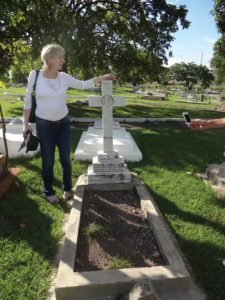
In September 2013, I visited my grandfather’s grave, located in what is now a Jamaican Defence Force facility. A young officer helped me to locate the spot and once there, he gave my grandfather a military salute, as my friends, Tina and Peter, and I stood to attention. It was an emotional visit. I was struck by how young my grandfather was when he died – only 48. His age hadn’t registered until I saw it on his tombstone. I imagined my mother as a 10-year-old, standing where I now stood, saying goodbye forever. I was sad to leave, but I was strangely comforted when I noticed that the grave next to his was that of a young Irish boy who died in 1926. John Francis, 8-year-old son of Patrick and Anne Quinn. They would continue to keep each other company, as they had for so many years, on this island so far away from home.
Many images found in this article can also be found on noelharty.net, the website of Noel Harty, William Egan’s grandson and the author’s brother.

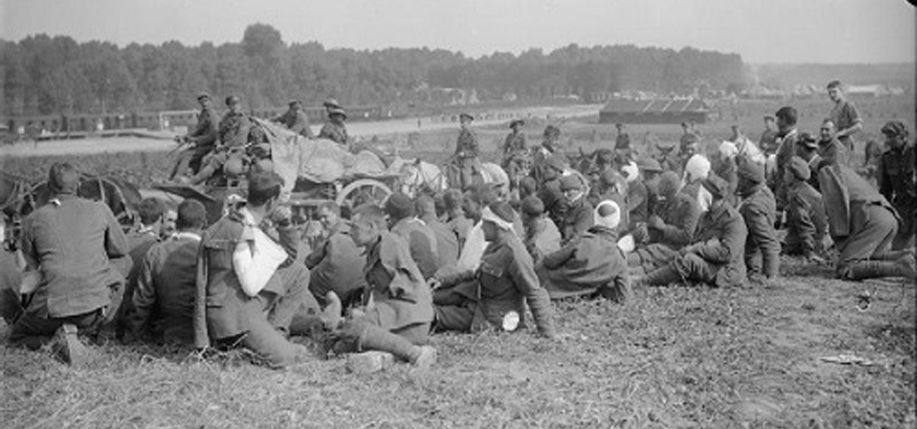
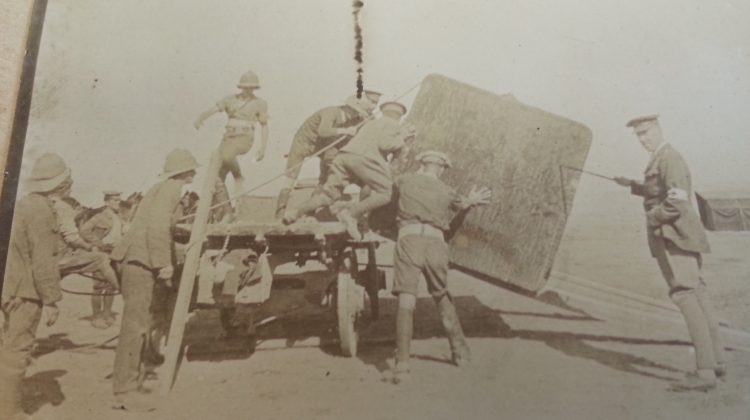
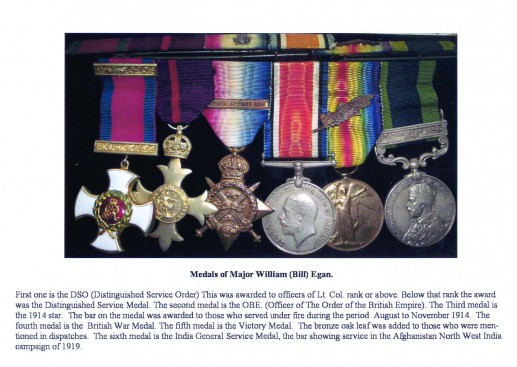
A wonderfully written, emotionally enlightening piece about my great grandfather, thank you Trish!
Thank you Trish for telling our Grandfathers story so well and completely. A touching Epilogue!
thank you Trish- a touching and sincere piece. I am researching my own grandfathers history at present-Alexander Edmond Knight also a graduate of the Royal University, and a Major in the RAMC. He was awarded the DSO and MC, but we have so many gaps in his story. Your grandfather’s story has given me renewed energy to carry on!
Jonathan
Hi Trish,
How wonderful to read about your amazing grandfather. What a life he lead in his 48
years! The many lives he saved on those battlefields, the horrors of war he must have witnessed, the adventures he must have experienced in India and Jamaica….an amazing life.
Kathleen Coffey Steimel
Trish
Fab story my dad landed in Normandy D Day +10 and I hope to retrieve his service record as he fought until the end of WW2 with 3rd Army (Patton)